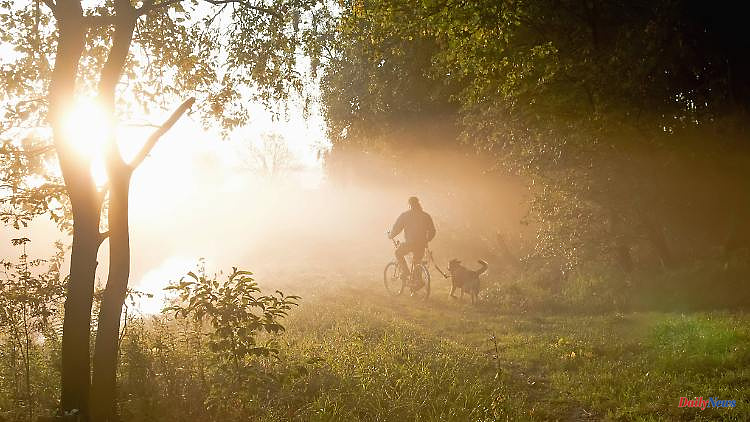Cycling and walking the dog - that can be easily combined. But not every four-legged friend is made for the endurance run next to the spokes. Alternative for tours and paths: dog transport.
If you want to go on a bike tour with your four-legged friend, there are a few things to consider: Is the animal suitable for the endurance run next to the spokes? Or is it better transported? In any case, the dog should be acclimated with patience so that the bike tour becomes a carefree pleasure for everyone.
As an active companion, the tracker must be physically fit. Running next to the bike is only for adult, healthy dogs, says Sarah Ross, pet expert at the animal welfare organization Four Paws. If in doubt, you can have your suitability and state of health checked by a veterinarian.
As a rule of thumb, Ross recommends a minimum age of one and a half years, because puppies with an immature musculoskeletal system can suffer health problems, as can unsuitable dogs that are overweight or old.
The breed also plays a role: While family dogs such as Beagles or Labradors, as well as herding dogs and hunting dogs, are quite enduring, dogs of short-headed breeds such as French or English bulldogs should not walk next to the bike for long. According to Ross, they are not suitable for cycling because of their physique.
"First of all, you should familiarize the dog with the bike while it's still standing," recommends Ross. If your four-legged friend has sniffed the bike, reward him with praise and treats. To introduce the dog to the new way of moving together, you first push the bike. If Bello willingly follows along, masters or mistresses can saddle up. "It's a good idea to practice in a restricted traffic area or in a parking lot," says Ross.
Alexander Giebler from the Bicycle Press Service (Pd-f), who often goes on bike tours with his Bandi hybrid, also advises "careful and short test rides in a quiet atmosphere" - for example on forest and meadow paths. According to the Road Traffic Act (StVO), walking a dog from a bicycle is also permitted on the street. He should only be leashed then.
"Make sure that you carry the leash with you as loosely as possible, i.e. do not tie it to your wrist or the handlebars. This will prevent accidents if the animal suddenly starts running," says a brochure from the Federal Ministry of Transport. For more safety, Giebler recommends walking the dog on bike paths and to the right of the bike if possible.
"You should also attach the leash to a harness and not the collar," adds pet expert Ross. There are also special bike mounts for dogs in specialist shops. According to the Industry Association for Pet Supplies (IVH), two solutions are common: spacers that keep the animal at a distance from the bike and shock absorbers that are supposed to compensate for sudden movements by Bello or Co. With both, the owner can keep both hands on the handlebars while riding, which promises more control over what is happening.
On the way you should always observe whether the dog is physically overwhelmed. The pace is best set by the four-legged friend. Depending on fitness and dog breed, ten kilometers in one go are possible, says Alexander Giebler. But if the dog pants heavily or slows down, it's probably just too much for him. At that point at the latest, a break is needed, which expert Ross advises on longer bike tours anyway: "Not only so that the dog can catch its breath, but also so that it can sniff and do its business."
Even if the dog isn't made for running along over longer distances, the bike tour doesn't have to be called off. "Smaller dogs ride in special bicycle baskets, larger dogs can be taken in small trailers as passengers," says Sarah Ross. Here, too, the following applies: the animal must be introduced to the transport step by step and acclimated with attention, praise and treats. This increases the chances of success on a harmonious tour.
If the dog knows the bicycle basket like its own basket, it will remain seated during the journey, says dog trainer and specialist book author Anton Fichtlmeier. There are also baskets that can be closed with a grid on the market. A basket on the handlebars is ideal to keep an eye on the dog while driving. However, because too much weight there can have a negative effect on handling, the animal should not weigh more than around five kilograms.
If the dog or bitch weighs more and is unsuitable for the sport, they can ride in the back - either in a basket for the luggage carrier or in the trailer. According to Pd-f, there are dog trailers in different sizes for dogs up to 45 kilograms on the market. The Pd-f reports an increased demand. E-bikers in particular bought a dog trailer if they wanted to ride longer distances that the dog couldn't complete.
The dog should be carefully accustomed to a trailer - because, according to Pd-f, it can have a very intimidating effect on the animal. To build trust, you can try a classic from puppy school: the tunnel exercise. To do this, you lure the animal into the trailer with a treat and then through it, after which you are rewarded.
Moving the feeding place into the trailer at home or hiding your favorite toy there or laying out the usual dog blanket also helps against possible stress. The first practice rounds with the dog and trailer should then be carried out just as carefully as getting used to the bicycle: first push the trailer with the dog on board before you hitch it up and start cycling.
Ideally, the dog jumps into the trailer itself, otherwise you lure him in as in the tunnel exercise, wait until he lies down and only then close the access hatch, according to the Pd-f. "If you want to make sure that Bello doesn't jump out while driving, you can use the tarpaulin that comes with the trailer," adds Anton Fichtlmeier. Experts do not necessarily recommend putting the dog on a leash in the trailer, it depends, among other things, on the character of the animal.
Getting used to riding a cargo bike is very similar, says Sarah Ross: build trust, praise getting on, first push, then ride. "If the dog shows anxiety or stressful behavior during one of the steps, be patient and return to the previous step first," advises the pet expert.
It is not a matter of course that every dog runs well on the bike or rides in a trailer or cargo bike. "Some dogs just don't like it, and as an owner, you have to accept that," says Ross. But with patience and attention, nothing should stand in the way of the common bike tour of humans and animals in most cases.
(This article was first published on Tuesday, August 02, 2022.)












